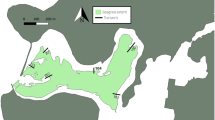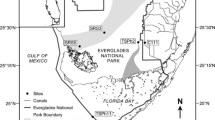Summary
A beaver pond can be considered an open ecosystem with a number of energy inputs and outputs. The net difference between input and output represents the accumulation of energy within the system. During 1973 input-output parameters were measured independently for one spring fed pond (surface area 736 m2) in the Kananaskis Valley, Alberta, Canada. The yearly energy budged indicated that allochthonous energy inputs into the pond were much greater than autochthonous inputs. Of the total yearly energy input 18% was exported, 26% was respired and 56% accumulated in the sediments. This percentage utilization for respiration was low when compared with similar data from the literature for live aquatic ecosystems elsewhere. However the actual annual mean sediment respiration rate of 8.4 ml m-1 hr-1 compared favourably with the figure of 6.1 ml m-2 hr-1 predicted from Hargrave's 1969 respiration equation for benthic communities. This situation suggests that the allochthonous input, while dominant, is highly refractive and rapidly becomes locked up in the sediments. The high photosynthesis-respiration ratio of 0.81 together with the results of earlier litter bag experiments (Hodkinson, 1975) support this conclusion. Thus the beaver pond is a highly accretive heterotrophic ecosystem.
Similar content being viewed by others
References
Fisher, S. G., Likens, G. E.: Energy flow in Bear Brook, New Hampshire: An integrative approach to stream ecosystem metabolism. Ecol. Monogr. 43, 421–439 (1973)
Hargrave, B. T.: Similarity of oxygen uptake by benthic communities. Limnol. Oceanogr. 14, 801–805 (1969)
Hodkinson, I. D.: Dry weight loss and chemical changes in vascular plant litter of terrestrial origin occurring in a beaver pond ecosystem. J. Ecol. 63, 131–142 (1975a)
Hodkinson, I. D.: A community analysis of the benthic insect fauna of an abandoned beaver pond. J. Anim. Ecol. 44, 535–553 (1975b)
Odum, H. T.: Primary production in flowing water. Limnol. Oceanogr. 1, 102–117 (1956)
Odum, H. T.: Trophic structure and productivity of Silver Springs, Florida. Ecol. Monogr. 27, 55–112 (1957)
Pritchard, G., Hall, H. A.: An introduction to the biology of craneflies in a series of abandoned beaver ponds, with an account of the life cycle of Tipula sacra Alexander (Diptera: Tipulidae). Canad. J. Zool. 49, 467–482 (1971)
Sedell, J. R., Triska, F. J., Hall, J. D., Anderson, N. H., Lyford, J. H.: Sources and fates of organic inputs in coniferous forest streams. Integrated research in the Coniferous forest Biome. Proceedings AIBS Symposium on Coniferous Forest Ecosystems. Conif. For. Biome. Bull. 5, 57–69 (1974)
Teal, J. M.: Community metabolism in a temperate cold spring. Ecol. Monogr. 27, 283–302 (1957)
Tilly, L. J.: The structure and dynamics of Cone Spring. Ecol. Monogr. 38, 169–197 (1968)
Wetzel, R. G., Manny, B. A.: Decomposition of dissolved organic carbon and nitrogen compounds from leaves in an experimental hard-water stream. Limnol. Oceanogr. 17, 927–931 (1972)
Author information
Authors and Affiliations
Rights and permissions
About this article
Cite this article
Hodkinson, I.D. Energy flow and organic matter decomposition in an abandoned beaver pond ecosystem. Oecologia 21, 131–139 (1975). https://doi.org/10.1007/BF00345556
Received:
Issue Date:
DOI: https://doi.org/10.1007/BF00345556




